Field Day Recap: Managed Grazing to Improve Pasture and Cropland
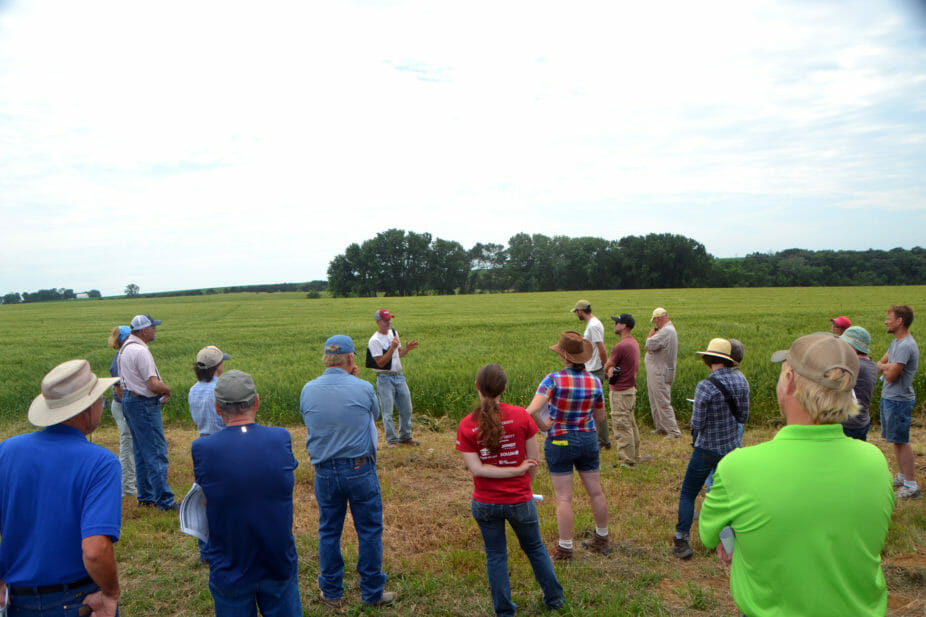
Nathan and Sarah Anderson of Bobolink Prairie Farms hosted a field day focused on rotational grazing, pasture improvement, cover crops and small grains on June 25th near Aurelia.
Nathan and Sarah Anderson welcomed field day attendees to their farm on Saturday, June 25 to learn about rotational grazing, pasture improvement, cover crops, small grains and to eat some fantastic smoked brisket raised on their farm. Nathan kicked off the field day by introducing the farm and having all the field day attendees introduce themselves and tell him a couple things they’d like to learn.

Nathan Anderson talks growing small grains and wheat management.
The first stop was what is perhaps the largest wheat field in Iowa (?) at 55 acres. Nathan talked in the wheat field first about why he decided to grow small grains, and then moved into some of the more practical aspects of growing wheat. Here’s a summary:
Why Grow Small Grains?
- Economic. With falling commodity prices, Nathan says that corn and soybeans are becoming merely break-even crops. After reading the research of Matt Liebman at Iowa Sate University, showing that the financial returns of 3 and 4 year rotations the same as 2 year rotations, he became intrigued. You can see Matt’s presentation from Aaron Lehman’s field day here.
- Cover crop seed. Because he raises lots of cover crops, growing small grains and saving the seed allows him to save money on cover crop seeding costs.
- Better use of the whole growing season. He says that growing small grains allows him to make better use of the early spring and late fall potential for growing crops.
- Improve the soil. While small grains themselves have a different rooting system than corn and soybeans, the diverse cover crop mix that Nathan will plant after harvesting his wheat will inject roots of different sizes into different depths of the soil, creating pathways for air and water movement, as well as beneficial soil organisms like earthworms.
- Diversify weed management. Because small grains germinate and grow at cooler temperatures, they can suppress a different set of weeds than corn and soybeans.
- Extend the grazing season. Nathan grows cover crops on corn and soybean ground to expand his pasture acreage without taking land out of row crop production. Growing a small grain allows him to expand that even further: planting a diverse cover crop mix in early August after the small grain harvest allows him to turn some of that summer heat into late season forage for his cattle.
- Good for Iowa. “I think diversity across the landscape is something that can help us as a state,” he says. He says that he believes that a more diverse farm economy will be more resilient: better to absorb shocks from volatile markets and weather.
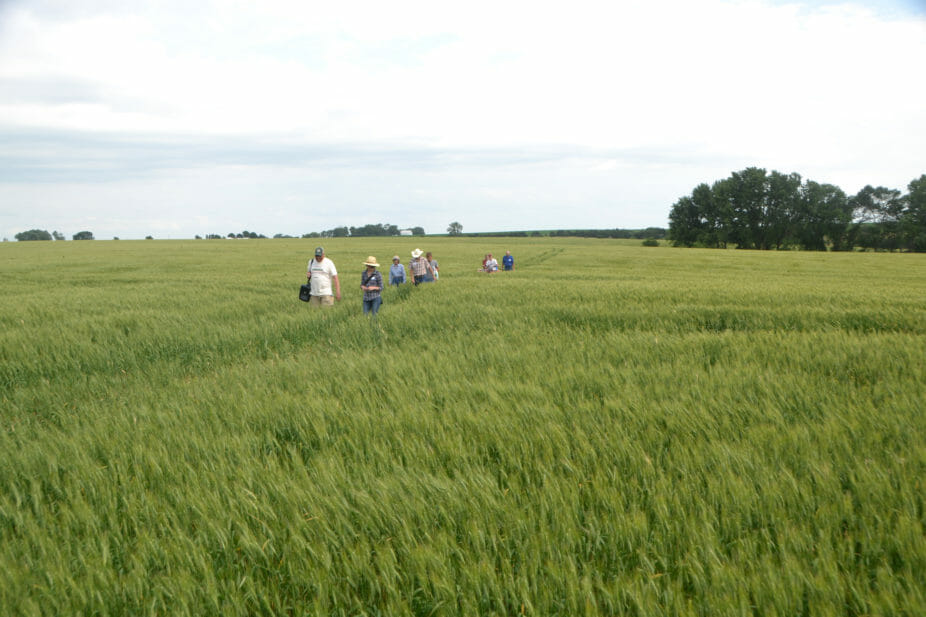
Growing small grains, such as wheat, allows Nathan to plant a multi-species mix in late summer that his cattle can graze late into the fall.
Wheat Production Details
After detailing the why of small grains production, he moved on to the how. Here’s a snapshot of Nathan’s management up until this point in the year:
Variety: Prevail – a hard red spring wheat developed in South Dakota. Prevail is a shorter variety, which Nathan says is important in the windy conditions on his farm — taller varieties may be prone to lodging.
Seeded: April 12 with an air seeder at 120 lbs/ac, vertical tilled into soybean stubble.
Fertilization: At planting: 60 lbs of N as urea, 60 lbs DAP; at flag leaf stage: 6 lbs urea based N as foliar, combined with fungicide application.
Disease Management: generic Quilt (fungicide) at flag leaf stage: curative for leaf diseases, preventative for plant diseases.
Herbicide: None. He intended to use Aim EC, but was too late, he needed to have sprayed before jointing. Husky was a post-jointing option, but had carry-over restrictions and grazing restrictions, so he opted not to spray.
Micronutrient Application: Applied micronutrient mix of calcium, copper and sulfur after pollination to help with diseases.
Market: He is aiming for food grade market, and has sold to Scoular in Blair, NE in the past.
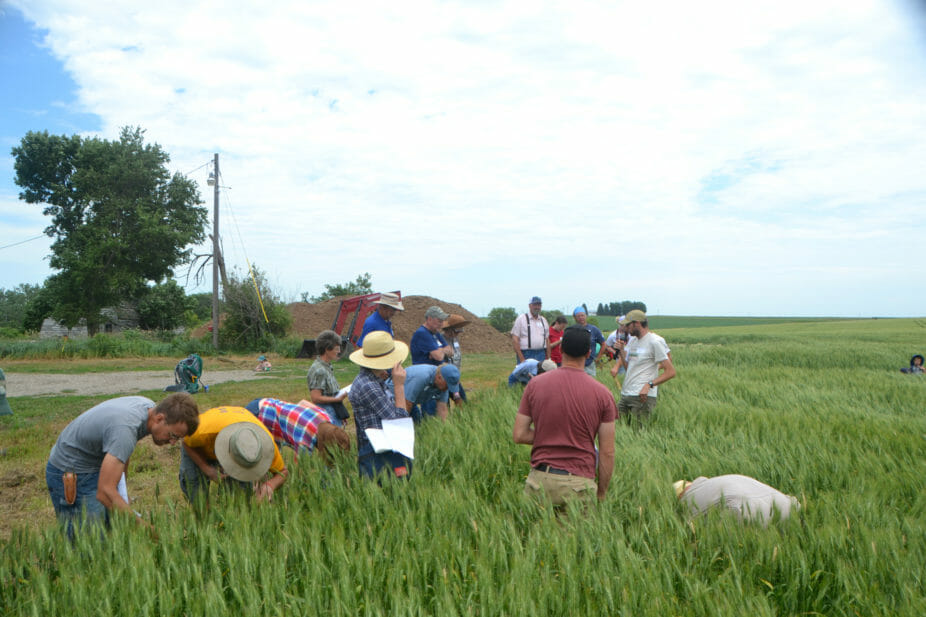
David Weisberger of Iowa State University instructs the crowd to look for wheat tillers at the base of the plants.
David Weisberger of Iowa State University spoke on some of the specifics of wheat production. He said before you plant anything, you should determine what market you’re shooting for: “Every decision you make should be based on the end use of the crop.” He emphasized two important factors in wheat production: seeding rate/plant populations and seed bed fitness. “A reliable bet, year to year, is to think about a target plant population. Know your rate in number of seeds, not just number of pounds. The number of seeds in a pound can vary significantly year to year,” he says. He says that can be determined pretty easily each year, by counting out a thousand seeds and using a seeding rate calculator to determine seeding rate, such as this calculator available on the PFI website.
The next thing to think about at planting time is seed bed fitness. David says that a firm seed bed is important to ensure good seed-to-soil contact, and uniform seeding depth. “We’re raising a population, not a collection of individuals, so we want all those plants coming up at the same time,” he says.
“If you’re thinking about inputs, you’re going to need to know about how and when small grains grow,” he says. He says that weed, disease and fertility management are all dependent on growth stages, so economic applications of various inputs depends on an understanding of those growth stages. You can find an easy to use Guide to Staging Small Grains on the PFI website.
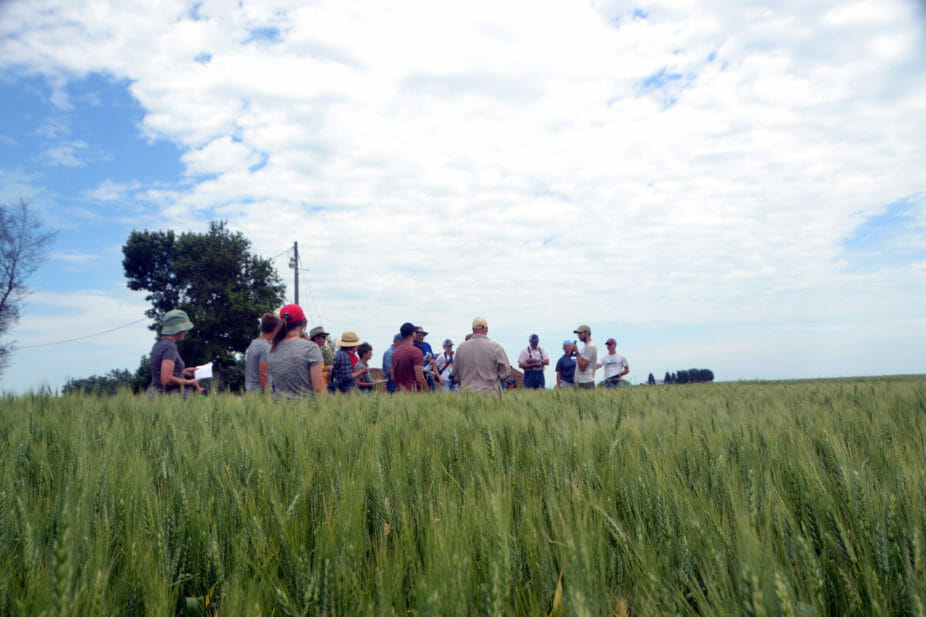
For more information on wheat production, and other small grains, visit practicalfarmers.org/small-grains.
Grazing Cover Crops
The final small grains topic that Nathan hit was grazing a multispecies cover crop mix after the small grains harvest.
He again referred to Matt Liebman’s research: “One of the assumptions of the system that Matt studies is that livestock eat the crops and then you spread the manure on the field. But that’s a lot of handling of bulk products,” he says, “I think we can do one better with an integrated crop and livestock farm. The cows do the consuming of forage and the returning of the manure on the spot. If nothing else, that’ll sure make my life easier.”
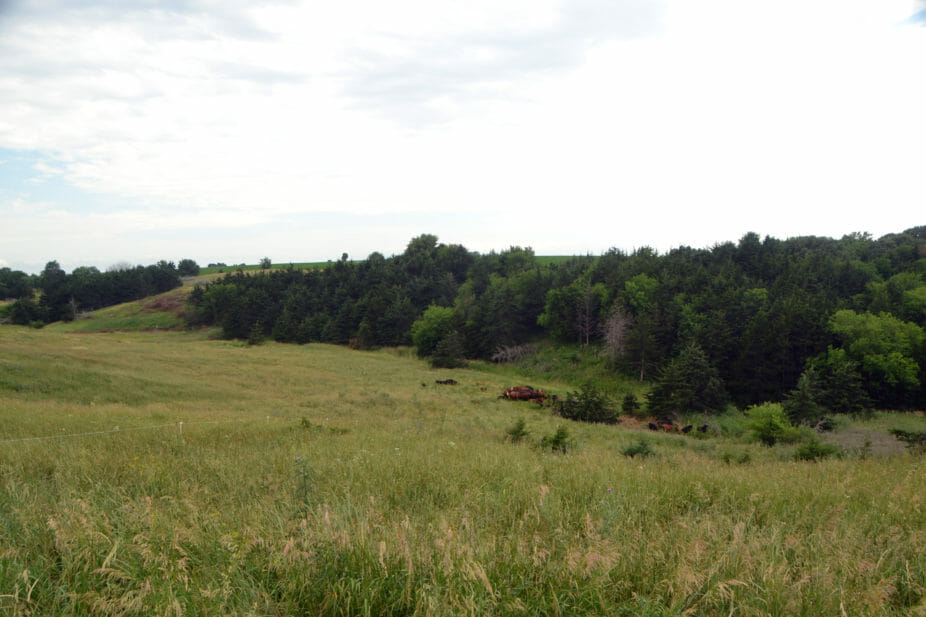
Cows graze on summer pasture at Bobolink Prairie Farms.
Nathan first started planting cover crops in 2012, when he aerially seeded winter rye. He says that rye is pretty tough to beat, and it provides some good spring grazing for his cattle, but there’s usually not enough fall growth for grazing.
“We’re looking to fill that gap in forage in the fall by planting cover crops after the small grains harvest. That way, we can capture some of that summer heat and graze it late into the fall,” he says. He says that he likes to get at least six species in that mix, if not more: a warm season and a cool season grass, a warm season and cool season legume, and a couple brassica species.
Grazing Management and Pasture Improvement
After talking small grains, Nathan led the crowd through the wheat field to see some of the pastures that he’s been working on improving via rotational grazing, cedar tree removal and interseeding legumes for many years.
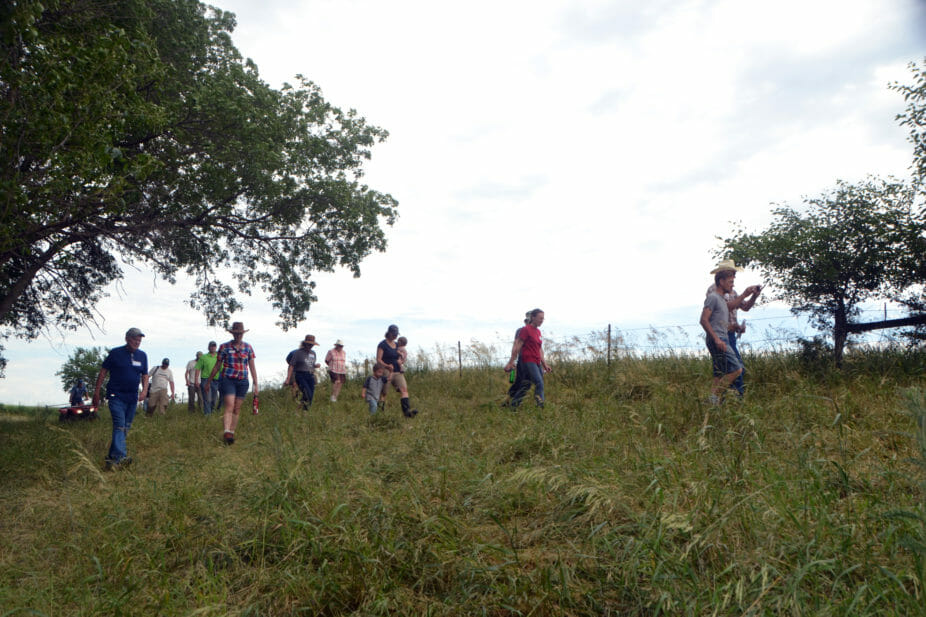
Field day attendees walk through a recently grazed pasture at Bobolink Prairie Farms.
A few key takeaways from Nathan’s talk on grazing.
- He practices high-density, mob-style grazing, moving the cattle once a day. In this system, the cattle graze some of the forage and trample down the rest. This combination adds manure to the top of the soil and organic matter below ground due to the constant sloughing off of roots. His goal is to graze 250,000 lbs cattle/acre.
- He regularly interseeds legumes into this pastures. He says this helps grass produce well when it otherwise wouldn’t be as productive.
- He uses Pharo Cattle Company genetics, whose cows have a smaller frame and are better suited to grass finishing, and can be more profitable, even though they’re smaller. “You have to keep in mind what you’re measuring,” he says. “With these smaller framed cattle, individuals might not gain as much, but the herd as a whole does better, and ultimately, we can be more profitable.”
- He talked about his contract grazing arrangement — a “calf share” agreement — whereby he gets to keep some of the calves each year. This gives him access to what would otherwise be very expensive genetics.
- They calve in mid-April through mid-May, a little later than many other farmers, but he says that works better for them. The cows are grazing overwintered cover crops on row crop ground, such as winter rye, and that works well in Nathan’s system. “Cover crops are a good transition from hay to pasture,” he says, “it allows their rumen to adapt and be ready to go when they get into the high quality forage.”

The crowd checks out Nathan’s cattle and examines two weeds that he constantly deals with: Canada thistle (in the foreground) and Eastern Red Cedar (in the background).
- Two big invasive species that cause problems in his pastures are Canada thistle and Eastern Red Cedar. Nathan says that red cedar can outcompete grass in an unmanaged pasture very rapidly, and that he’s been battling the cedars for years. Torray Wilson of 7 W Farms near Paullina weighed on thistles: “I think fall grazing sets up a thistle problem for next year. Sometimes we’re better to lay off, let the forage stockpile and save ourselves some problems in the future.” David Weisberger of ISU recommended killing thistle when it’s flowering. “That’s when the plant has the majority of its resources aboveground, and when it’s most susceptible to being killed in whatever way you choose,” he says.
- He has fencing along streams but still allows controlled access to water. This means that the cattle will spend less time in the water, which not only improves water quality for downstream and ensures clean water for cows and calves.
- Nathan recommended that people look into NRCS programs to help with various pasture improvement practices, such as cedar tree removal, water and fencing for rotational grazing, and fencing along streams.
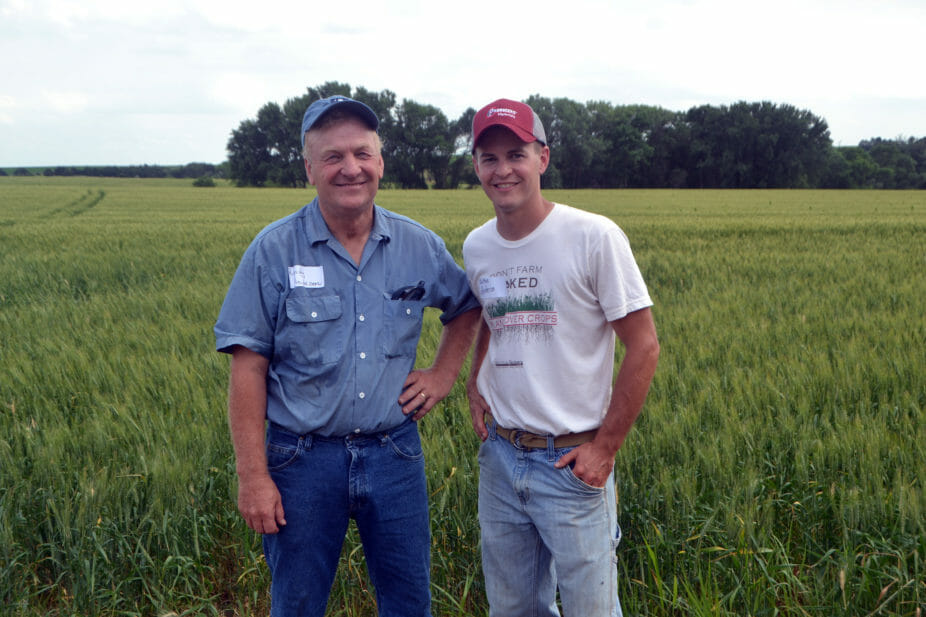
Nathan and his dad Randy. Nathan thanked his dad throughout the field day for the opportunity to farm the family land and to try new things, even if the two don’t always agree.
The field day concluded with a BBQ that included some delicious smoked brisket from Nathan’s cattle. PFI would like to thank the sponsors for Nathan and Sarah’s field day: Cherokee County Soil and Water Conservation District, Green Cover Seed and Super D Ag.
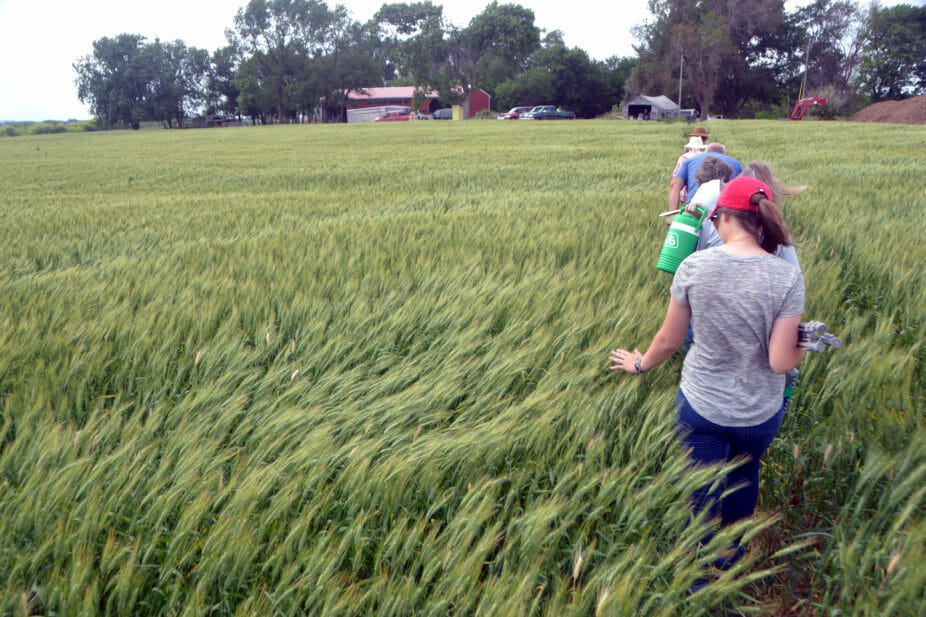
Field day attendees return from the pasture through the soon-to-be amber waves of grain.
